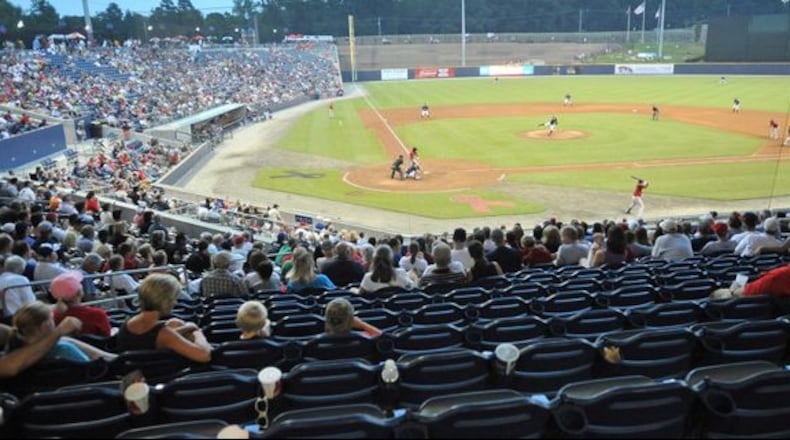After opening the stadium with 423,556 fans in its first year, attendance at Coolray Field has decreased in all but one season since the Gwinnett Braves arrived in 2009. Total attendance has fallen 36.2 percent since the first season.
Year…..Total attendance…..Year-over-year percent change
2010…..337,240…..20.4 percent decrease
2011…..351,565…..4.2 percent increase
2012…..327,584…..6.8 percent decrease
2013…..323,799…..1.2 percent decrease
2014…..303,959…..6.1 percent decrease
2015…..270,336…..11.1 percent decrease
Seven years into the experiment that is the Gwinnett Braves, the numbers make it clear: The county built it. They have not come.
Attendance at the minor league ball club is second-to-last in the league, down more than a third since the team came to northern Gwinnett in 2009. None of the planned shops or restaurants has materialized. Naming rights for the ballfield brought in half of what was expected.
“They made every mistake possible,” said J.C. Bradbury, a professor of sport management and economics at Kennesaw State University. “You’re not going to put your park in the middle of nowhere and expect people to come there. You put the park where people are already going.”
Back in 2008, when county commissioners decided without public input to build a new stadium and pursue baseball, they said it would be an economic driver for the largely undeveloped area.
Such over-promises are common for stadium projects, Bradbury said. But those high expectations are rarely met. And in Gwinnett, over-optimistic projections "were not just rosy, they were flat-out wrong," he said.
The team has never attracted the 468,000 people a year a feasibility study said it would. The stores, restaurants and hotel that were supposed to draw even more dollars still haven't been built.
Sabrina Smith, a Lawrenceville resident who is chairman of Georgia Watchdogs, said broken promises like those lead taxpayers to lose trust in their officials, even when they have good ideas.
“It’s unfortunate taxpayers are saddled with a burden like this when they were told it was going to benefit taxpayers,” Smith said. “I don’t see it ever catching up.”
As a result of lower-than-expected income from parking and ticket sales, the county has had to divert tourism dollars that would have gone toward the Infinite Energy Center, or to promote Gwinnett, back to paying off Coolray Field. Right now, the income the stadium is bringing in isn't enough to cover bond payments for Coolray.
Gwinnett’s total tax contribution to the field will reach more than $1.6 million this year — up by more than $400,000. The money is taken from taxes collected on car rental fees and hotel stays.
But leaders remain optimistic.
Talking about what else the money could be used for “is not very productive for me,” Gwinnett Commission Chairman Charlotte Nash said. Nash wasn’t on the county commission in 2008 when the board approved the stadium, or when it agreed later to pay an additional $19 million to build it after design decisions led costs to increase to $64 million.
But she agrees with others that part of the reason the project has had less of an impact than expected is because the team came and the stadium opened during the Great Recession, making it difficult to sell naming rights, fund construction and lure fans.
“The timing was pretty difficult, since the economy went in the tank,” Nash said. “A lot of the excitement didn’t go anywhere.”
The 270,336 people who attended a Gwinnett Braves game this season was lower than the Gwinnett Braves’ attendance in their last year in Richmond, when 289,570 people watched them play. This year’s attendance was just 58 percent of original projections, and far lower than the league-leading Charlotte Knights, who had 669,398 spectators. The only city with attendance worse than Gwinnett’s was Syracuse with 262,408 fans.
A lower fan base might have discouraged further construction around the stadium.
Former Commissioner Bert Nasuti, who left the board in 2010, pushed the idea of bringing a minor league team to Gwinnett. While he acknowledged there can be some “tough nights” when it comes to filling the stands, Nasuti said Coolray is “what I envisioned from Day One.”
“I’m confident their market share will grow and improve,” he said. “At the end of the day, it’s just a great amenity. It’s what I hoped to bring to Gwinnett. I certainly hope people continue to discover it, use it.”
Steve Vibert, who asked his wife to marry him at a minor league baseball game in Chattanooga, went to about a dozen Gwinnett Braves game this season. But the Suwanee resident said the team has failed to connect with the community, and that tickets are overpriced when there are plenty of other lower-cost entertainment options around.
He used to bring groups of people from church to games with him, but the crowds of 20 dwindled to 10, then they found other things to do.
Chuck Warbington, the head of the county’s planning commission, let his season tickets go this year. His family loved to go, but his children are at an age where it’s hard for them to make the games, he said. He made it to just one, for work.
“There’s so much to do in Gwinnett County,” Warbington said. “It kind of gets lost in the shuffle.”
It’s the job of North Johnson, the Gwinnett Braves general manager, to make the team stand out. In an emailed response to questions, Johnson said he is not happy with attendance and that the team’s ticket department now emphasizes group sales and ticket packages for fewer games.
Recovering from the hit of the recession has “been a slower process for us,” he wrote, but the team has many promotions to entice people to games.
“The downturn in the economy is what affected the timing of the development as well as every other business across America,” he wrote.
Because the team moved to Gwinnett during the recession, it missed the opportunity to create a “foundational fan base” of season ticket holders that help sustain the franchise, said Stan Hall, executive director of the Gwinnett Sports Commission. And, Hall said, “Atlanta sports fans are a fairly fickle bunch.”
“We’re so close to Atlanta, it certainly has to be an issue,” he said.
Hall said there is a small, loud group of people who are opposed to the Gwinnett Braves completely.
In addition to baseball games, the stadium has hosted food trucks, a recycling event and public safety fairs. The stadium might be used for other sports during baseball’s off-season, Hall said.
Whether the stadium is working can’t only be measured by metrics like attendance, Hall said. Having a Triple-A baseball team in the county has helped Gwinnett achieve national recognition that it may not have gotten otherwise, he said. And awareness helps with economic development and other kinds of recruitment.
Nash, the county chairman, said it was still too soon to tell whether the move will be a good one, in the long term.
“The jury is still out as far as what will happen out there, to a large extent,” she said. “I see no reason why there wouldn’t be a way for it to have a good, long-term effect.”
About the Author
Keep Reading
The Latest
Featured




